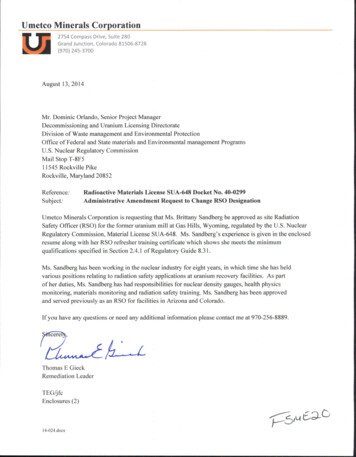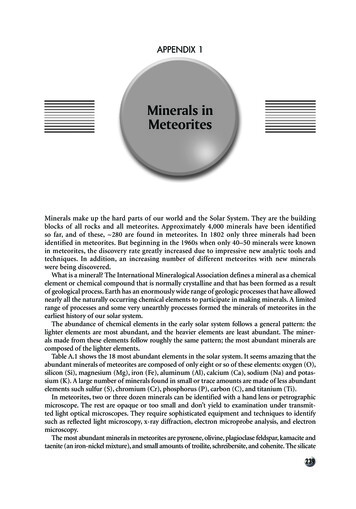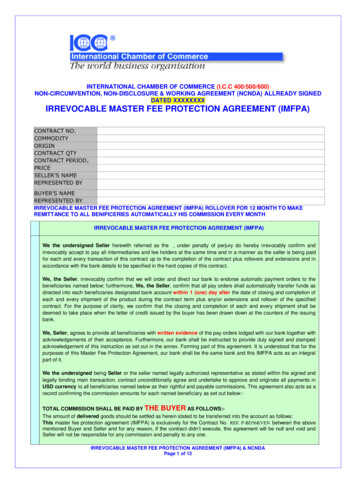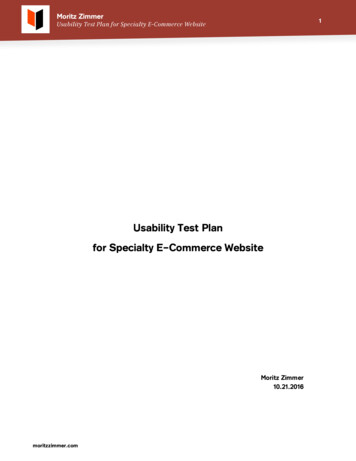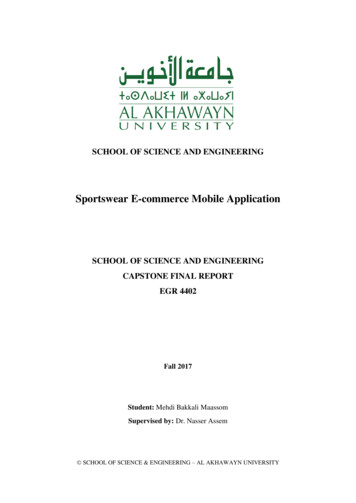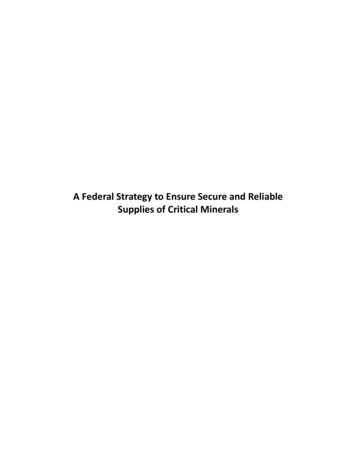
Transcription
A Federal Strategy to Ensure Secure and ReliableSupplies of Critical Minerals
ContentsExecutive Summary .3Introduction .6Approach .12Calls to Action .14Call to Action 1: Advance Transformational Research, Development, andDeployment Across Critical Mineral Supply Chains .14Call to Action 2: Strengthen America’s Critical Mineral Supply Chains and DefenseIndustrial Base .22Call to Action 3: Enhance International Trade and Cooperation Related to CriticalMinerals .27Call to Action 4: Improve Understanding of Domestic Critical Mineral Resources 31Call to Action 5: Improve Access to Domestic Critical Mineral Resources onFederal Lands and Reduce Federal Permitting Timeframes .37Call to Action 6: Grow the American Critical Minerals Workforce .44Next Steps .48Conclusion .49Abbreviations .50
Executive SummaryThe assured supply of critical minerals1 and the resiliency of their supply chains areessential to the economic prosperity and national defense of the United States. TheUnited States is heavily dependent on foreign sources of critical minerals and on foreignsupply chains resulting in the potential for strategic vulnerabilities to both our economyand military. Mitigating these risks is important and consistent with our country’sNational Security Strategy and National Defense Strategy to promote Americanprosperity and to preserve peace through strength.The United States imports most critical mineral commodities. Specifically, the UnitedStates is import-reliant (imports are greater than 50 percent of annual consumption)for 31 of the 35 minerals designated as critical by the Department of the Interior.2 TheUnited States does not have any domestic production and relies completely on importsto supply its demand for 14 critical minerals.3To address this problem and reduce the Nation’s vulnerability to disruptions in thesupply of critical minerals, President Donald J. Trump issued Executive Order 13817, AFederal Strategy to Ensure Secure and Reliable Supplies of Critical Minerals, on December20, 2017. The Executive Order directs the Secretary of Commerce, in coordination withheads of selected executive branch agencies and offices, to submit a report to thePresident that includes:(i)“a strategy to reduce the Nation’s reliance on critical minerals;(ii)an assessment of progress toward developing critical mineralsrecycling and reprocessing technologies, and technologicalalternatives to critical minerals;(iii) options for accessing and developing critical minerals throughinvestment and trade with our allies and partners;123As defined in Executive Order 13817, a critical mineral is “a mineral identified by the Secretary of theInterior [pursuant to the Executive Order] to be (i) a non-fuel mineral or mineral material essential tothe economic and national security of the United States, (ii) the supply chain of which is vulnerableto disruption, and (iii) that serves an essential function in the manufacturing of a product, theabsence of which would have significant consequences for our economy or our national security.”82 Fed. Reg. 60835; 2017; t of the Interior, “Final List of Critical Minerals 2018,” 83 Fed. Reg. 23295; 2018U.S. Geological Survey, “Mineral Commodity Summaries 2018,” 2018,https://doi.org/10.3133/701949323
(iv) a plan to improve the topographic, geologic, and geophysicalmapping of the United States and make the resulting data andmetadata electronically accessible, to the extent permitted by lawand subject to appropriate limitations for purposes of privacy andsecurity, to support private sector mineral exploration of criticalminerals; and(v)recommendations to streamline permitting and review processesrelated to developing leases; enhancing access to critical mineralresources; and increasing discovery, production, and domesticrefining of critical minerals.”This report, A Federal Strategy to Ensure Secure and Reliable Supplies of Critical Minerals,presents 6 Calls to Action, 24 goals, and 61 recommendations that describe specificsteps that the Federal Government will take to achieve the objectives outlined inExecutive Order 13817.When executed, this strategy will improve the ability of the advanced technology,industrial, and defense manufacturing sectors that use critical minerals to adapt toemerging mineral criticality issues; reduce risks for American businesses that rely oncritical minerals; create a favorable U.S. business climate for production facilities atdifferent stages of critical mineral supply chains; and support the economic securityand national defense of the United States; all of which will reduce the Nation’svulnerability to critical mineral supply disruptions.The Calls to Action outlined in this Strategy are listed below.1. Advance Transformational Research, Development, and Deployment AcrossCritical Mineral Supply Chains: Assesses progress toward developing criticalminerals recycling and reprocessing technologies, technological alternatives tocritical minerals, source diversification, and improving processes for criticalmineral extraction, separation, purification, and alloying.2. Strengthen America’s Critical Mineral Supply Chains and Defense IndustrialBase: Discusses ways to improve critical mineral supply chains, which couldhelp reduce risks to U.S. supply by increasing domestic critical mineral resourcedevelopment, building robust downstream manufacturing capabilities, andensuring sufficient productive capacity.3. Enhance International Trade and Cooperation Related to Critical Minerals:Identifies options for accessing and developing critical minerals throughinvestment and trade with America’s allies, discusses areas for internationalcollaboration and cooperation, and ensures robust enforcement of U.S. trade4
laws and international agreements that help address adverse impacts ofmarket-distorting foreign trade conduct.4. Improve Understanding of Domestic Critical Mineral Resources: Provides aplan to: improve and publicize the topographical, geological, geophysical, andbathymetrical mapping of the United States; support mineral informationcollection and analysis of commodity-specific mitigation strategies; focus andprioritize interagency efforts; and conduct critical mineral resource assessmentsto support domestic mineral exploration and development of conventionalsources (minerals obtained directly through mining an ore), secondary sources(recycled materials, post-industrial, and post-consumer materials), andunconventional sources (minerals obtained from sources such as mine tailings,coal byproducts, extraction from seawater, and geothermal brines) of criticalminerals.5. Improve Access to Domestic Critical Mineral Resources on Federal Landsand Reduce Federal Permitting Timeframes: Provides recommendations tostreamline permitting and review processes related to developing mining claimsor leases and enhancing access to domestic critical mineral resources.6. Grow the American Critical Minerals Workforce: Discusses the activitiesrelated to critical minerals needed to develop and maintain a strong domesticworkforce to foster a robust domestic industrial base.5
IntroductionCritical minerals4 are needed for many products used by Americans in everyday life,such as cell phones, computers, automobiles, and airplanes. These minerals are alsoused to make many other products important to the American economy and defense,including advanced electronics; manufacturing equipment; electricity generation,storage, and transmission systems; transportation systems; defense systems and othermilitary supplies; cutting-edge medical devices; and other critical infrastructuresystems.The assured supply of these critical minerals, and the resiliency of their supply chains,are essential to the United States’ economic security and national defense. As shown inFigure 1, the United States is heavily dependent on foreign sources of critical minerals.Specifically, the United States is import-reliant (imports are greater than 50 percent ofannual consumption) for 31 of the 35 minerals designated as critical by the Departmentof the Interior (DOI).5 The United States does not have any domestic production andrelies completely on imports to supply its demand for 14 critical minerals.Mitigating risks associated with foreign dependence on sources of critical minerals isimportant and consistent with the National Security Strategy6 and National DefenseStrategy7 to promote American prosperity and to preserve peace through strength. Thedependency of the United States on foreign sources of critical minerals creates astrategic vulnerability for both our economy and our military with respect to adverseforeign government actions, natural disasters, and other events that could disruptsupply.All stages of the critical mineral supply chain are important and can impact one another.For example, increasing the rate of mining without increasing corresponding4As defined in Executive Order 13817, a critical mineral is “a mineral identified by the Secretary of theInterior [pursuant to the Executive Order] to be (i) a non-fuel mineral or mineral material essential tothe economic and national security of the United States, (ii) the supply chain of which is vulnerableto disruption, and (iii) that serves an essential function in the manufacturing of a product, theabsence of which would have significant consequences for our economy or our national security.”82 Fed. Reg. 60835; 2017; nt of the Interior, “Final List of Critical Minerals 2018,” 83 Fed. Reg. 23295; 20186Trump, Donald J., “National Security Strategy of the United States of America,” /2017/12/NSS-Final-12-18-2017-0905.pdf7Department of Defense, “Summary of the 2018 National Defense Strategy of the United States ofAmerica,” 2018, 018-National-DefenseStrategy-Summary.pdf6
processing and manufacturing capabilities will simply move the source of economicand national security risk further down the supply chain and create dependence onforeign sources for these capabilities.7
Figure 1: 2017 U.S. Net Import Reliance for Critical Minerals88Adapted from U.S. Geological Survey, “Mineral Commodity Summaries 2018,” 2018, https://doi.org/10.3133/701949328
Currently, the United States lacks domestic processing and manufacturing capabilitiesfor some critical minerals, which results in the export of domestically produced oresand concentrates for further processing into more value-added products. Lack ofdomestic processing and manufacturing capabilities for critical materials makes theUnited States vulnerable to potential geo-economic and geo-political actions fromforeign governments that may lead to price and demand volatility for specific minerals,as well as potential supply disruptions causing mineral shortfalls.Addressing vulnerabilities in the critical minerals supply chain through an increase indomestic exploration, production, recycling, reprocessing, industry incentives, andresearch and development (R&D) investments would help reduce our Nation’s relianceon imports, preserve our leadership in technological innovation, support job creation,and improve our national security and balance of trade. Implementing theseinvestments and policies also enhances the technological superiority and readiness ofour Armed Forces, which are among the United States' largest and most importantconsumers of critical minerals.9To address the risk to critical mineral supply chains, President Donald J. Trump issuedExecutive Order 13817, A Federal Strategy to Ensure Secure and Reliable Supplies ofCritical Minerals.10 The order states, “It shall be the policy of the Federal Government toreduce the Nation’s vulnerability to disruptions in the supply of critical minerals, whichconstitutes a strategic vulnerability for the security and prosperity of the United States.The United States will further this policy for the benefit of the American people and in asafe and environmentally responsible manner, by:(a)identifying new sources of critical minerals;(b)increasing activity at all levels of the supply chain, includingexploration, mining, concentration, separation, alloying, recycling,and reprocessing critical minerals;(c)ensuring that our miners and producers have electronic access to themost advanced topographic, geologic, and geophysical data wit
20, 2017. The Executive Order directs the Secretary of Commerce, in coordination with heads of selected executive branch agencies and offices, to submit a report to the President that includes: (i) “a strategy to reduce the Nation’s reliance on critical minerals (ii) an assessment of progress toward developing critical minerals recycling and reprocessing technologies, and technological .


